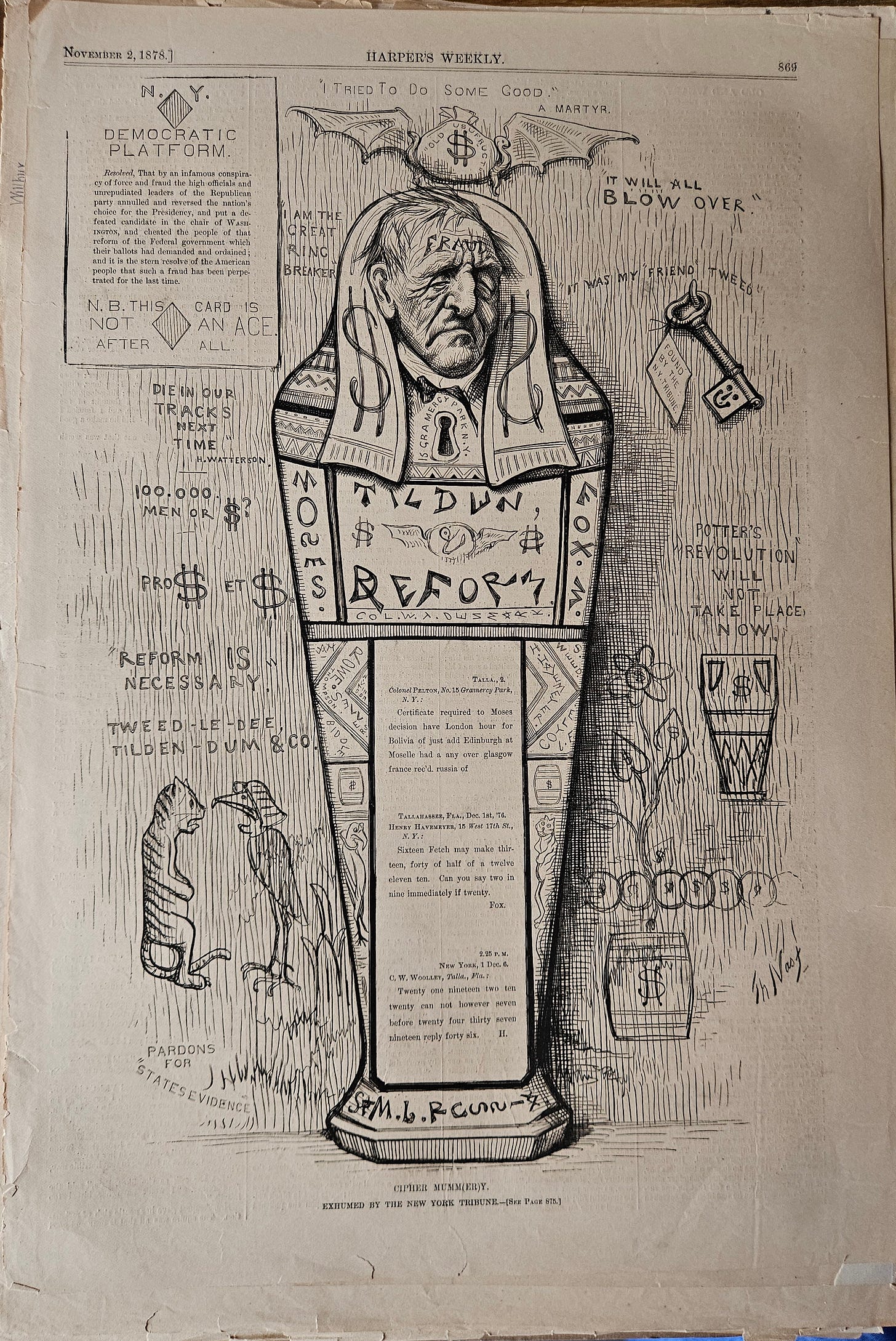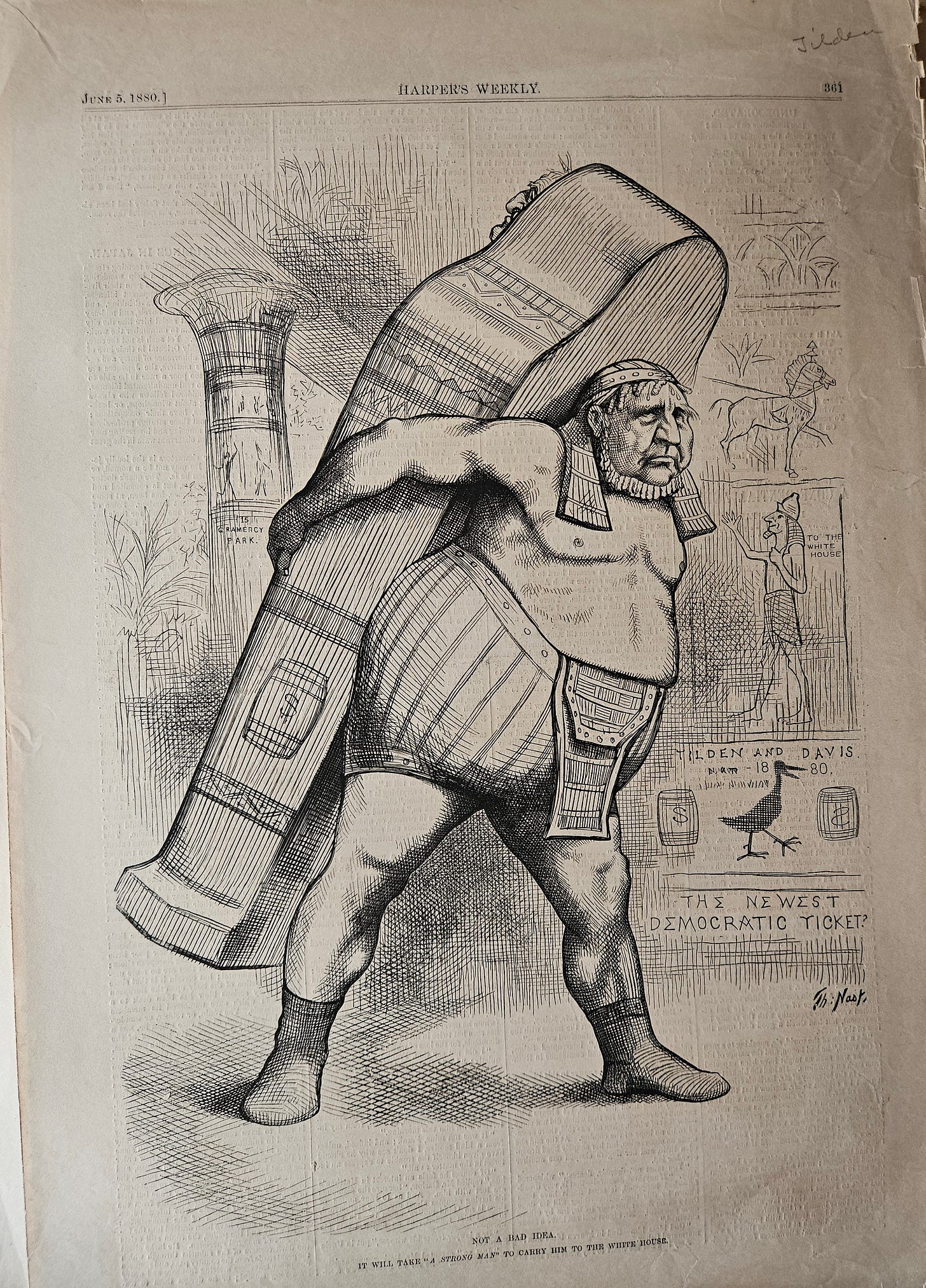ANOTHER NAST Drawings (11/2/1878 and others) of Samuel Tilden -he ran against Rutherford B. Hayes, who WON THE highly disputed.US PRESIDENCY. Click on links to learn interesting history!
https://millercenter.org/the-presidency/educational-resources/disputed-election-1876
Nast drawing: (Nov. 1, 1878): CIPHER MUMM(ER)Y
(TEXT FROM <https://thomasnast.com/cartoons/cipher-mummery/>)
• Code names: Moses (Marble), Woolley (Fox), Tilden (Russia), and Pelton (Denmark).
• Tilden’s residence at 15 Gramercy Park: The key (“found by the Tribune”) was to the right of Tilden’s face while the keyhole was under his chin.
• The $ symbol: On a prehistoric Egyptian bird over Tilden’s head and on his chest; on a sprouting barrel of flowers (lower right); and on an Egyptianized container (above the barrel).
The winner of the November 7, 1876 election between Republican Rutherford Hayes and Democrat Samuel Tilden could not be decided until the 19 electoral votes of four contested states — Louisiana (8), South Carolina (7), Florida (3) and Oregon (1) — were determined. If Tilden received just one vote, he would be President.
The so-called Returning Boards in each state would make the decisions, and were open to bribery. Manton Marble, the Democratic publisher of the New York World, tried and failed to bribe the Chairman of the three-man board in Florida. He used encrypted telegrams to obtain funding via Tilden’s nephew, William Pelton, who lived in his uncle’s bachelor home in New York.
The Marble-Pelton bribery scheme unexpectedly came to light more than a year into the Hayes Administration. In May 1878, the Democratic House, still smarting over Tilden’s loss, formed an investigating committee chaired by Clarkson Potter (NY) to try to prove that “Rutherfraud” Hayes was an illegitimate President. Although the committee was stacked with Hayes’s political enemies, its investigation foundered after several weeks because of weak evidence and the President’s openness.
Suddenly, the political witch hunt backfired, providing Nast a tremendous opportunity to continue flaying Tilden. The Tribune learned that a Republican Senate committee had a batch of incriminating telegrams, probably obtained illicitly from Western Union. Playing cat-and-mouse beginning in August, it printed bits and pieces of the translated telegrams over several weeks. In an expanded edition on October 7, it published its first major exposé detailing correspondence between Marble, C.W. Woolley (a Democrat “fixer”) and Pelton. It explained how it acquired and deciphered the telegrams, including the coded originals and their translations. The reluctant Potter Committee was forced to investigate. Marble wiggled and lied, but Pelton confessed.
The Tribune’s revelations sparked new creativity in Nast’s cartoons. They enabled him to add another layer of symbolism, inventively uniting the encryption of the encoded telegrams, the pictorial language of Egyptian hieroglyphics, and his own visual emblems and verbal puns into a complex riddle that his readers could appreciate and solve without undue difficulty. His first response incorporated several inspired pieces into the puzzle.
What was the irony of history that occurred in 1876? (A “GOOGLE” QUESTION gave this answer below):
“So it is a great irony of history that the election of 1876 officially crushed the American dream for millions of black Americans. This election saw Rutherford B. Hayes, the Republican candidate and eventual winner, square off against Samuel J. Tilden, the Democratic nominee.”
**(Most of us Bay Area people have visited ‘Tilden Park,’ and wondered who that was named after…)
CLICK HERE: Full Explanation of Nast drawing (above).
————-
1876: SAMUEL TILDEN VRS. RUTHERFORD B. HAYES: (Google says this:)
One of the MOST CONTROVERSIAN PRESIDENTIAL ELECTIONS was between Samuel Tilden and Rutherford B. Hayes. Tilden, a Democrat, won the popular vote by nearly 250,000 votes, over 3%. On the night of the election, both candidates, as well as most of the national media, assumed Tilden was the winner.
David Davis CARRIES THE “TILDEN MUMMY”
Thomas Nast not only lampooned Samuel Tilden's age and infirmity by drawing him in numerous cartoons as an Ancient Egyptian sarcophagus, but the artist sometimes pictured the Tilden mummy-casket as a burden on the back of another person (e.g., Louisville Courier-Journal editor Henry Watterson or 1880 Democratic presidential nominee Winfield Hancock), here, David Davis.
Complete HARP WEEK Explanation (SEE BELOW) <https://elections.harpweek.com/1880/cartoon-1880-large.asp?UniqueID=7&Year=1880>:
In 1876, when disputed electoral college returns resulted in uncertainty as to which candidate, Democrat Samuel Tilden or Republican Rutherford Hayes, had won the presidential election, Davis became a major figure in the unfolding drama. Congressional Democrats agreed to establish a bipartisan electoral commission to resolve the dispute, and thus decide the election, because they assumed that Justice Davis would be the deciding vote. Democrats thought that Davis, an independent with Democratic leanings by that time, would be sympathetic to their case. Instead, Davis resigned from the Court and the commission after being elected to the Senate by a coalition of Democrats and Greenbackers in the Illinois legislature (until 1913 state legislatures elected U.S. senators).
Some political observers suggested a national ticket of Tilden and Davis could be a winning combination for Democrats in 1880. Nast, a Republican, seems to agree-"Not a Bad Idea"-but the proposal primarily allows him to ridicule both Tilden and Davis's girth.
Senator David Davis of Illinois had been a key figure in national politics for twenty years. In 1860, he served as Abraham Lincoln's campaign manager, then was appointed by President Lincoln to the U.S. Supreme Court in 1862. His high court tenure is best remembered for his authorship of the majority opinion in Ex Parte Milligan (1866), which ruled that the military trial and conviction of a civilian outside of the theater of war, where the civil courts were functioning, violated the Constitution. Like his judicial colleague, Chief Justice Salmon Chase, Davis yearned to be president himself. In 1872, Davis was a leading contender for the nomination of the Liberal Republican party, but lost to New York Tribune editor Horace Greeley.
———






Fascinating, these are. Yes, I recall as a child in the fifties addicted to a panoply of cartoons, then years later in art school, discovering Michelangelo's cartoons, altogether something else, more about the paper and preparation for paintings, especially his cartoon method for those great murals in the Sistine Chapel.
Wow. Cartooning was, in a way, more developed as an "art form" back then, perhaps more so than it is now, because it tried to do so much more at the time.